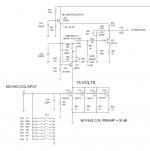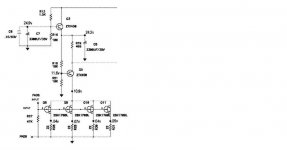I already built and tested both channels of the Pearl phonostage. The initial results are really promising. The sound is very good. Thanks Promitheus for the parts and pcb. Now I am sure I need some extra gain for the MC cartridge, as planned.
I am exploring the "parallel way" as pointed by Tarasque (thanks for the info) and trying to get the mentioned article from the journal of Audio eng. I could start with something theoretical, and if I come up with something "doable" and "payable" I might try a prototype.
Do you guys more experienced in the forum think I should start a new thread or we keep everything related to the Pearl here?
Xavier
I am exploring the "parallel way" as pointed by Tarasque (thanks for the info) and trying to get the mentioned article from the journal of Audio eng. I could start with something theoretical, and if I come up with something "doable" and "payable" I might try a prototype.
Do you guys more experienced in the forum think I should start a new thread or we keep everything related to the Pearl here?
Xavier
xavier1000 said:Do you guys more experienced in the forum think I should start a new thread...
Yes please, it keeps everything easier to find.
I would like to see the MC frontend powered off from the Pearl board. I was thinking of giving the MC frontend its own capacitance multiplier reg. like in the original, powered from right after the first regulator stage on the Pearl board. Just have to figure out a decent way to connect itDo you guys have any ideas what would be needed?

Steen
Yes, that seems to be correctThe best way to connect the power is directly from the resistor R13 on the Pearl board.
Steen
Thanks, Promitheus. I am safe then, having a little healthy supplyI think its the BL like in the Pearl.
of those.
Steen
Well I am working on the layout.
Only on paper till now.
Trying to make something that looks similar to the Pearl but from the Aleph Ono circuit.
it has the 8 input resistors with dip switch and 2 dip switches to set gain.
there are 2 220uF parallel to 47n Capacitors where the signal goes through.
What should I use here?
These should be good quality.
the 220uF can only be electrolytic at a few volts but I dont know yet how many. the 47n can either be MKP or silvered mica maybe (which is expensive but good)
Only on paper till now.
Trying to make something that looks similar to the Pearl but from the Aleph Ono circuit.
it has the 8 input resistors with dip switch and 2 dip switches to set gain.
there are 2 220uF parallel to 47n Capacitors where the signal goes through.
What should I use here?
These should be good quality.
the 220uF can only be electrolytic at a few volts but I dont know yet how many. the 47n can either be MKP or silvered mica maybe (which is expensive but good)
Just to get things started I made a photo of the MC Preamp part.
here it is.
It contains the MC Sub Regulator and it will be powered from the Pearls +29 Volts.
Do you think it will work OK?
The capacitors I refered to in the previous post are C37, CB4, C19 and CB3. The signal goes through these so they should be of very good quality.
What do you think is the best solution here?
here it is.
It contains the MC Sub Regulator and it will be powered from the Pearls +29 Volts.
Do you think it will work OK?
The capacitors I refered to in the previous post are C37, CB4, C19 and CB3. The signal goes through these so they should be of very good quality.
What do you think is the best solution here?
Attachments
After some reading I came to the conclusion that creating an MC phono stage by puting 4 parallel input stages was too complex and the benefits not very clear.
So I finally came back to the earth.
I am
So I finally came back to the earth.
Is anybody else interested in an MC preamp for the Pearl?
I am
When comparing the Ono MC part with the input stage of the Pearl (attached file), the main difference is Q15.
I know this might seem a stupid question, but if I'm not wrong both stages have similar voltage gain, so what is the purpose of Q15 in the Ono?
Another diference I noticed is the .15 uF (C6 in pearl) bypassing C7 3300uF (C35 in Ono). Do you think it would be a good idea to leave space for this cap?
Regarding C19 and C37, how about BG NX's 220uF? Is 6.3V enough?
I know this might seem a stupid question, but if I'm not wrong both stages have similar voltage gain, so what is the purpose of Q15 in the Ono?
Another diference I noticed is the .15 uF (C6 in pearl) bypassing C7 3300uF (C35 in Ono). Do you think it would be a good idea to leave space for this cap?
Regarding C19 and C37, how about BG NX's 220uF? Is 6.3V enough?
Attachments
Promitheus:
I was just browsing the site and noticed your moving coil adapter. I have a couple of comments that relate to the capacitors.
The 10 dB gain reduction technique you use changes the corner frequency of C37 by about a 100 to 1 and the corner frequency of C17 by about 4 to 1 both could be dangerous for stability. (Don't you want controlled turn over somewhere around 4-6 Hz?)
If you add one more resistor in the collector of Q14 as a stack, you could have several gains without that big change in turn over frequency. You just select a gain tap thats right, perhaps 3 taps in all (5 or 6 dB steps?)
By keeping the input Z of the Q15 buffer high and constant you could lower the total capacitance by almost a hundred to 1 allowing the use of known good metal and film capacitors (i.e. tin and polypropolyne) while keeping capacitor costs merely sky high instead of insane. This scheme also keeps the corner frequencies independent of gain selection.
I just don't like electrolytics in series with audio signals, films are better IMHO.
I was just browsing the site and noticed your moving coil adapter. I have a couple of comments that relate to the capacitors.
The 10 dB gain reduction technique you use changes the corner frequency of C37 by about a 100 to 1 and the corner frequency of C17 by about 4 to 1 both could be dangerous for stability. (Don't you want controlled turn over somewhere around 4-6 Hz?)
If you add one more resistor in the collector of Q14 as a stack, you could have several gains without that big change in turn over frequency. You just select a gain tap thats right, perhaps 3 taps in all (5 or 6 dB steps?)
By keeping the input Z of the Q15 buffer high and constant you could lower the total capacitance by almost a hundred to 1 allowing the use of known good metal and film capacitors (i.e. tin and polypropolyne) while keeping capacitor costs merely sky high instead of insane. This scheme also keeps the corner frequencies independent of gain selection.
I just don't like electrolytics in series with audio signals, films are better IMHO.
xavier1000
I have noticed that and it would be simpler to use the same circuit as the Pearl.
First I like it better.
Second you dont have to use that 220uF Cap in series with the signal.
Thats what I dont like about the XONO.
I think the input circuit of the Pearl would work with a 10uF Cap coupling MC and MM parts. 10uF of the same quality as the one in the Pearl.
The problem is how do we make the Gain changes.
If you check the ONO Circuit you can see that the -4dB change is made with Q14 which is a 2sc1844.
The PEarl has a ZTX450.
Which one is better for the MC? Is the 2sc1844 a low noise type or something?
Why does the ONO MC Circuit have +30dB with 499+499= 998 Ohm Load and the Pearl +29dB with only 499 Ohms.
If you short the one resistor in the Ono and have only 499 Ohm Load you go down to +26dB.
The input is no problem. I just use dip switches there to set the input impendance.
Is the 100pF cap there universal enough?
I know that MC Pickups only need Resistive imp. Match, but do some also need another capacitance there?
I have noticed that and it would be simpler to use the same circuit as the Pearl.
First I like it better.
Second you dont have to use that 220uF Cap in series with the signal.
Thats what I dont like about the XONO.
I think the input circuit of the Pearl would work with a 10uF Cap coupling MC and MM parts. 10uF of the same quality as the one in the Pearl.
The problem is how do we make the Gain changes.
If you check the ONO Circuit you can see that the -4dB change is made with Q14 which is a 2sc1844.
The PEarl has a ZTX450.
Which one is better for the MC? Is the 2sc1844 a low noise type or something?
Why does the ONO MC Circuit have +30dB with 499+499= 998 Ohm Load and the Pearl +29dB with only 499 Ohms.
If you short the one resistor in the Ono and have only 499 Ohm Load you go down to +26dB.
The input is no problem. I just use dip switches there to set the input impendance.
Is the 100pF cap there universal enough?
I know that MC Pickups only need Resistive imp. Match, but do some also need another capacitance there?
hermanv
the circuit is not mine.
It is from Wayne Colburn from Pass Labs.
Its a reference product in the High End branch so I dont really think its unstable or has any problems what so ever.
It is one of the top 3 Phono stages in the world.
The number one tested Phono stage costs 10 time more.
Thats a very good idea. I really like it.
but do we need this buffer at all?
And what happens to the noise level when we make the input Z of the buffer from 100K to 10M.
If Wayne Colburn could help here it would be cool.
the circuit is not mine.
It is from Wayne Colburn from Pass Labs.
Its a reference product in the High End branch so I dont really think its unstable or has any problems what so ever.
It is one of the top 3 Phono stages in the world.
The number one tested Phono stage costs 10 time more.
By keeping the input Z of the Q15 buffer high and constant you could lower the total capacitance by almost a hundred to 1 allowing the use of known good metal and film capacitors (i.e. tin and polypropolyne) while keeping capacitor costs merely sky high instead of insane. This scheme also keeps the corner frequencies independent of gain selection.
Thats a very good idea. I really like it.
but do we need this buffer at all?
And what happens to the noise level when we make the input Z of the buffer from 100K to 10M.
If Wayne Colburn could help here it would be cool.
- Status
- This old topic is closed. If you want to reopen this topic, contact a moderator using the "Report Post" button.
- Home
- Group Buys
- Pearl phono PCBs Group Buy

